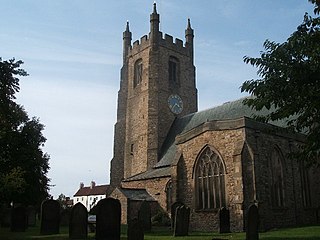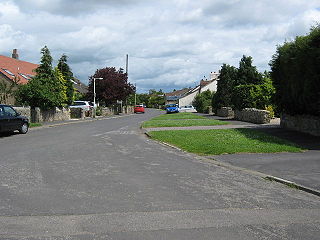In the folklore of Northumbria, the Sockburn Worm was a ferocious wyvern that laid waste to the village of Sockburn in Durham. It was said that the beast was finally slain by John Conyers. The tale is said by many to be the inspiration for Lewis Carroll's poem Jabberwocky which he wrote while in Croft-on-Tees and Whitburn. [1]
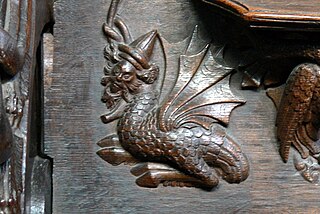
A wyvern is a legendary bipedal dragon with a tail often ending in a diamond- or arrow-shaped tip. A sea-dwelling variant dubbed the sea-wyvern has a fishtail in place of a barbed dragon's tail.

Sockburn is a village and former civil parish to the south of Darlington in County Durham, England. It is situated at the apex of a meander of the River Tees, known locally as the Sockburn Peninsula. Today, all that remains of the village is an early nineteenth-century mansion, a ruined church and a farmhouse built in the late eighteenth century.

Durham is a historic city and the county town of County Durham in North East England. The city lies on the River Wear, to the south-west of Sunderland, south of Newcastle upon Tyne and to the north of Darlington. Founded over the final resting place of St Cuthbert, its Norman cathedral became a centre of pilgrimage in medieval England. The cathedral and adjacent 11th-century castle were designated a World Heritage Site by UNESCO in 1986. The castle has been the home of Durham University since 1832. HM Prison Durham is also located close to the city centre. City of Durham is the name of the civil parish.
Each newly consecrated Bishop-Prince of Durham, while entering the Bishopric for the first time at the local Ford or over the bridge over the River Tees at Croft-on-Tees, was presented with the falchion that John Conyers used on the worm. The Lord of Sockburn traditionally reads a speech while presenting the blade:

The Bishop of Durham is the Anglican bishop responsible for the Diocese of Durham in the Province of York. The diocese is one of the oldest in England and its bishop is a member of the House of Lords. Paul Butler has been the Bishop of Durham since his election was confirmed at York Minster on 20 January 2014. The previous bishop was Justin Welby, Archbishop of Canterbury. The bishop is one of two who escort the sovereign at the coronation.
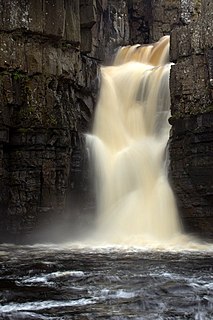
The River Tees is in northern England. It rises on the eastern slope of Cross Fell in the North Pennines, and flows eastwards for 85 miles (137 km) to reach the North Sea between Hartlepool and Redcar near Middlesbrough.
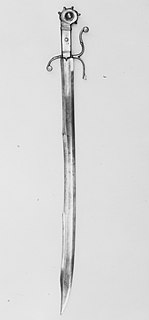
A falchion is a one-handed, single-edged sword of European origin, whose design is reminiscent of the Chinese dadao, and modern machete. Falchions are found in different forms from around the 13th century up to and including the 16th century. In some versions the falchion looks rather like the seax and later the sabre, and in other versions the form is irregular or like a machete with a crossguard.
"My Lord Bishop. I hereby present you with the falchion wherewith the champion Conyers slew the worm, dragon or fiery flying serpent which destroyed man, woman and child; in memory of which the king then reigning gave him the manor of Sockburn, to hold by this tenure, that upon the first entrance of every bishop into the county the falchion should be presented."
The bishop would then take the falchion, and immediately return it, wishing the holder health and long enjoyment of the manor. [2]
The tale of the worm may be inspired by the longships of marauding Vikings, who carved the heads of Worms (Ormr) on the bow, [3] however this does not take into account the commonness of dragons in Germanic folklore including that of Northumbria (see the Laidly and Lambton Worms as well as the Worm of Linton).

Longships were a type of specialised Viking warships that have a long history in Scandinavia, with their existence being archaeologically proven and documented from at least the fourth century BC. Originally invented and used by the Norsemen for commerce, exploration, and warfare during the Viking Age, many of the longship’s characteristics were adopted by other cultures, like Anglo-Saxons and continued to influence shipbuilding for centuries. The longship's design evolved over many centuries, beginning in the Stone Age with the invention of the umiak and continuing up until the 6th century with clinker-built ships like Nydam and Kvalsund. The longship appeared in its complete form between the 9th and 13th centuries. The character and appearance of these ships have been reflected in Scandinavian boat-building traditions until today. The particular skills and methods employed in making longships are still used worldwide, often with modern adaptations. They were all made out of wood, with cloth sails and had numerous details and carvings on the hull.

The bow is the forward part of the hull of a ship or boat, the point that is usually most forward when the vessel is underway. Both of the adjectives fore and forward mean towards the bow. The other end of the boat is the stern.

The Laidly Worm of Spindleston Heugh, also known as The Laidly Worm of Bamborough, is a Northumbrian ballad about a princess who is changed into a dragon.
The Sockburn Worm, with the falchion embedded in it, appears on the district badge of the local Darlington & District Scout Association.
